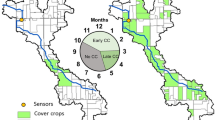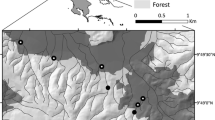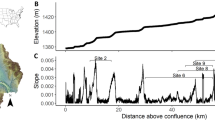Abstract
Ecosystem metabolism is an important determinant of trophic structure, nutrient cycling, and other critical ecosystem processes in streams. Whereas watershed- and local-scale controls on stream metabolism have been independently investigated, little is known about how controls exerted at different scales interact to determine stream metabolic rates, particularly in urban streams and across seasons. To address this knowledge gap, we measured ecosystem metabolism in four urban and four reference streams in northern Kentucky, USA, with paired closed and open riparian canopies, during each of the four seasons. Gross primary production (GPP), ecosystem respiration, and net ecosystem production (NEP) were all best predicted by models with season as a main effect, but interactions between season, canopy, and watershed varied for each response. Urban streams exhibited higher GPP during most seasons, likely due to elevated nutrient loads. Open canopy reaches in both urban and forested streams, supported higher rates of GPP than the closed canopy which reaches during the summer and fall, when the overhead vegetation shaded the closed reaches. The effect of canopy cover on GPP was similar among urban and forested streams. The combination of watershed and local-scale controls resulted in urban streams that alternated between net heterotrophy (NEP <0) and net autotrophy (NEP >0) at the reach-scale during seasons with dense canopy cover. This finding has management relevance because net production can lead to accumulation of algal biomass and associated issues like nighttime hypoxia. Our study suggests that although watershed urbanization fundamentally alters ecosystem function, the preservation and restoration of canopied riparian zones can provide an important management tool at the local scale, with the strongest impacts on stream metabolism during summer.




Similar content being viewed by others
References
Acuna V, Giorgi A, Munoz I, Uehlinger U, Sabater S. 2004. Flow extremes and benthic organic matter shape the metabolism of a headwater Mediterranean stream. Freshwater Biology 49: 960-971.
Allan JD. 2004. Landscapes and riverscapes: The influence of land use on stream ecosystems. Annual Review of Ecology Evolution and Systematics 35: 257-284.
American Public Health Administration. 2005. Standard methods for the examination of water and wastewater. American Public Health Administration, Washington DC.
Bates D, Maechler M. 2010. Lme4: Linear mixed-effects models using S4 classes. R package version 0.999375-37.
Bailey RG. 1995. Description of the ecoregions of the United States. 2nd edition. U.S. Department of Agriculture, Forest Service. Washington, D.C., U.S.A.
Beauchamp VB, Swan CM, Szlavecz K, Hu J. 2015. Riparian community structure and soil properties of restored urban streams. Ecohydrology 8: 880-895.
Beaulieu JJ, Arango CP, Balz DA, Shuster WD. 2013. Continuous monitoring reveals multiple controls on ecosystem metabolism in a suburban stream. Freshwater Biology 58: 918-937.
Bernhardt ES, Likens GE, Hall RO, Buso DC, Fisher SG, Burton TM, Meyer JL, McDowell WH, Mayer MS, Bowden WB, Findlay SEG, Macneale KH, Stelzer RS, Lowe WH. 2005. Can’t see the forest for the stream? - In-stream processing and terrestrial nitrogen exports. Bioscience 55: 219-230.
Bernhardt ES, Palmer MA. 2007. Restoring streams in an urbanizing world. Freshwater Biology 52: 738-751.
Bernhardt ES, Sudduth EB, Palmer MA, Allan JD, Meyer JL, Alexander G, Follastad-Shah J, Hassett B, Jenkinson R, Lave R, Rumps J, Pagano L. 2007. Restoring rivers one reach at a time: Results from a survey of US river restoration practitioners. Restoration Ecology 15: 482-493.
Bernot MJ, Sobota DJ, Hall RO, Mulholland PJ, Dodds WK, Webster JR, Tank JL, Ashkenas LR, Cooper LW, Dahm CN, Gregory SV, Grimm NB, Hamilton SK, Johnson SL, McDowell WH, Meyer JL, Peterson B, Poole GC, Valett HM, Arango C, Beaulieu JJ, Burgin AJ, Crenshaw C, Helton AM, Johnson L, Merriam J, Niederlehner BR, O’Brien JM, Potter JD, Sheibley RW, Thomas SM, Wilson K. 2010. Inter-regional comparison of land-use effects on stream metabolism. Freshwater Biology 55: 1874-1890.
Bond NR, Lake PS. 2003. Characterizing fish-habitat associations in streams as the first step in ecological restoration. Austral Ecology 28: 611-621.
Bott TL, Brock JT, Dunn CS, Naiman RJ, Ovink RW, Petersen RC. 1985. Benthic community metabolism in 4 temperate stream systems - an inter-biome comparison and evaluation of the river continuum concept. Hydrobiologia 123: 3-45.
Bott TL, Newbold JD, Arscott DB. 2006. Ecosystem metabolism in piedmont streams: Reach geomorphology modulates the influence of riparian vegetation. Ecosystems 9: 398-421.
Burnham KP, Anderson DR. 2002. Model selection and multi-model inference: a practical information theoretic approach. Second edition. Springer-Verlag, New York, NY, U.S.A.
Carpenter SR, Caraco NF, Correll DL, Howarth RW, Sharpley AN, Smith VH. 1998. Nonpoint pollution of surface waters with phosphorus and nitrogen. Ecological Applications 8: 559-568.
Chapra SC, Ditoro DM. 1991. Delta method for estimating primary production, respiration, and reaeration in streams. Journal of Environmental Engineering-Asce 117: 640-655.
Demars BOL, Manson JR, Olafsson JS, Gislason GM, Gudmundsdottir R, Woodward G, Reiss J, Pichler DE, Rasmussen JJ, Friberg N. 2011. Temperature and the metabolic balance of streams. Freshwater Biology 56: 1106-1121.
Demars BOL, Thompson J, Manson JR. 2015. Stream metabolism and the open diel oxygen method: Principles, practice, and perspectives. Limnology and Oceanography-Methods 13: 356-374.
Doane TA, Horwath W. 2003. Spectrophotometric Determination of Nitrate with a Single Reagent. Analytical Letters 36: 2713-2722.
Dodds WK, Biggs BJF, Lowe RL. 1999. Photosynthesis-irradiance patterns in benthic microalgae: Variations as a function of assemblage thickness anc community structure. Journal of Phycology 35: 42-53.
Dodds WK, Welch EB. 2000. Establishing nutrient criteria in streams. Journal of the North American Benthological Society 19: 186-196.
Fisher SG, Likens GE. 1973. Energy flow in Bear Brook, New Hampshire - integrative approach to stream ecosystem metabolism. Ecological Monographs 43: 421-439.
Folke C, Jansson A, Larsson J, Costanza R. 1997. Ecosystem appropriation by cities. Ambio 26: 168-172.
Grace MR, Giling DP, Hladyz S, Caron V, Thompson RM, Mac Nally R. 2015. Fast processing of diel oxygen curves: Estimating stream metabolism with BASE (BAyesian Single-station Estimation). Limnology and Oceanography-Methods 13: 103-114.
Grimm NB, Fisher SG. 1989. Stability of periphyton and macroinvertebrates to disturbance by flash floods in a desert stream. Journal of the North American Benthological Society 8: 293-307.
Guasch H, Marti E, Sabater S. 1995. Nutrient enrichment effects on biofilm metabolism in a Mediterranean stream. Freshwater Biology 33: 373-383.
Hagen EM, McTammany ME, Webster JR, Benfield EF. 2010. Shifts in allochthonous input and autochthonous production in streams along an agricultural land-use gradient. Hydrobiologia 655: 61-77.
Hall RO, Beaulieu JJ. 2013. Estimating autotrophic respiration in streams using daily metabolism data. Freshwater Science 32: 507-516.
Hession WC, Pizzuto JE, Johnson TE, Horwitz RJ. 2003. Influence of bank vegetation on channel morphology in rural and urban watersheds. Geology 31: 147-150.
Hill BH, Hall RK, Husby P, Herlihy AT, Dunne M. 2000. Interregional comparisons of sediment microbial respiration in streams. Freshwater Biology 44: 213-222.
Hill WR, Roberts BJ, Francoeur SN, Fanta SE. 2011. Resource synergy in stream periphyton communities. Journal of Ecology 99: 454-463.
Hill WR, Ryon MG, Schilling EM. 1995. Light limitation in a stream ecosystem - responses by primary producers and consumers. Ecology 76: 1297-1309.
Homer CG, Dewitz, JA, Yang L, Jin S, Danielson P, Xian G, Coulston J, Herold ND, Wickham JD, Megown, K. 2015. Completion of the 2011 National Land Cover Database for the conterminous United States-Representing a decade of land cover change information. Photogrammetric Engineering and Remote Sensing 81: 345-354
Holtgrieve GW, Schindler DE, Branch TA, A’Mar ZT. 2010. Simultaneous quantification of aquatic ecosystem metabolism and reaeration using a Bayesian statistical model of oxygen dynamics. Limnology and Oceanography 55: 1047-1063.
Izagirre O, Agirre U, Bermejo M, Pozo J, Elosegi A. 2008. Environmental controls of whole-stream metabolism identified from continuous monitoring of Basque streams. Journal of the North American Benthological Society 27: 252-268.
Jordan TE, Correll DL, Weller DE. 1997. Relating nutrient discharges from watersheds to land use and streamflow variability. Water Resources Research 33: 2579-2590.
Kentucky Division of Water (KDOW). 2008. Standard Methods for Assessing Biological Integrity of Surface Waters in Kentucky . Environmental and Public Protection Cabinet, Department for Environmental Protection, Frankfort, KY.Odum HT. 1956. Primary production in flowing waters. Limnology and Oceanography. 2:102-117.
Konrad CP, Booth DB. 2005. Hydrologic changes in urban streams and their ecological significance. Brown LR, Gray RH, Hughes RM, Meador MR editors. Effects of Urbanization on Stream Ecosystems.
LeBlanc RT, Brown RD, FitzGibbon JE. 1997. Modeling the effects of land use change on the water temperature in unregulated urban streams. Journal of Environmental Management 49: 445-469.
Lovett G, Cole J, Pace M. 2006. Is net ecosystem production equal to ecosystem carbon accumulation? Ecosystems 9: 152-155.
Marcarelli AM, Baxter CV, Mineau MM, Hall RO. 2011. Quantity and quality: unifying food web and ecosystem perspectives on the role of resource subsidies in freshwaters. Ecology 92:1215-1225.
Meyer JL, Paul MJ, Taulbee WK. 2005. Stream ecosystem function in urbanizing landscapes. Journal of the North American Benthological Society 24: 602-612.
Meyer JL, Strayer DL, Wallace JB, Eggert SL, Helfman GS, Leonard NE. 2007. The contribution of headwater streams to biodiversity in river networks. Journal of the American Water Resources Association 43: 86-103.
Mulholland PJ. 1997. Organic matter dynamics in the West Fork of Walker Branch, Tennessee, USA. Journal of the North American Benthological Society 16: 61-67.
Mulholland PJ, Fellows CS, Tank JL, Grimm NB, Webster JR, Hamilton SK, Marti E, Ashkenas L, Bowden WB, Dodds WK, McDowell WH, Paul MJ, Peterson BJ. 2001. Inter-biome comparison of factors controlling stream metabolism. Freshwater Biology 46: 1503-1517.
Mulholland PJ, Houser JN, Maloney KO. 2005. Stream diurnal dissolved oxygen profiles as indicators of in-stream metabolism and disturbance effects: Fort Benning as a case study. Ecological Indicators 5: 243-252.
Murphy J, Riley JP. 1962. A modified single solution method for the determination of phosphate in natural waters. Analytica Chimica 27: 31–36.
National Climatic Data Center (NCDC), NOAA Satellite and Information Service. 2008. Data obtained for Cincinnati Northern KY Airport, Covington/Cincinnati, KY, United States.
Palmer MA, Ambrose RF, Poff NL. 1997. Ecological theory and community restoration ecology. Restoration Ecology 5: 291-300.
Paul MJ, Meyer JL. 2001. Streams in the urban landscape. Annual Review of Ecology and Systematics 32: 333-365.
Plummer M, Best N, Cowles K, Vines K. 2006. CODA: Convergence diagnosis and output analysis for MCMC. R News 6:7-11.R Development Core Team. 2014. R: A language and environment for statistical computing. R Foundation for Statistical Computing, Vienna, Austria. ISBN 3-900051-07-0, URL http://www.R-project.org.
Ray JA, Webb JS, O’Dell PW, 1994. Groundwater Sensitivity Regions of Kentucky. Kentucky Department of Environmental Protection, Division of Water, Groundwater Branch, Lexington, Kentucky, U.S.A.
Reavie ED, Jicha TM, Angradi TR, Bolgrien DW, Hill BH. 2010. Algal assemblages for large river biomonitoring: Comparison among biovolume, absolute, and relative abundance metrics. Ecological Indicators 10: 167-177.
Reichert P, Uehlinger U, Acuna V. 2009. Estimating stream metabolism from oxygen concentrations: Effect of spatial heterogeneity. Journal of Geophysical Research-Biogeosciences 114: 2156-2202.
Riley AJ, Dodds WK. 2012. The expansion of woody riparian vegetation, and subsequent stream restoration, influences the metabolism of prairie streams. Freshwater Biology 57: 1138-1150.
Roberts BJ, Mulholland PJ, Hill WR. 2007. Multiple scales of temporal variability in ecosystem metabolism rates: Results from 2 years of continuous monitoring in a forested headwater stream. Ecosystems 10: 588-606.
Roy AH, Faust CL, Freeman MC, Meyer JL. 2005. Reach-scale effects of riparian forest cover on urban stream ecosystems. Canadian Journal of Fisheries and Aquatic Sciences 62: 2312-2329.
Sinsabaugh RL. 1997. Large-scale trends for stream benthic respiration. Journal of the North American Benthological Society 16: 119-122.
Snyder CD, Young JA, Villella R, Lemarie DP. 2003. Influences of upland and riparian land use patterns on stream biotic integrity. Landscape Ecology 18: 647-664.
Sudduth EB, Hassett BA, Cada P, Bernhardt ES. 2011. Testing the Field of Dreams Hypothesis: functional responses to urbanization and restoration in stream ecosystems. Ecological Applications 21: 1972-1988.
Sweeney BW, Bott TL, Jackson JK, Kaplan LA, Newbold JD, Standley LJ, Hession WC, Horwitz RJ. 2004. Riparian deforestation, stream narrowing, and loss of stream ecosystem services. Proceedings of the National Academy of Sciences of the United States of America 101: 14132-14137.
Tank JL, Rosi-Marshall EJ, Griffiths NA, Entrekin SA, Stephen ML. 2010. A review of allochthonous organic matter dynamics and metabolism in streams. Journal of the North American Benthological Society 29: 118-146.
Uehlinger U. 2000. Resistance and resilience of ecosystem metabolism in a flood-prone river system. Freshwater Biology 45: 319-332.
United States Department of Agriculture. 2011. Major land uses of the United States, 2007. Economic Information Bulleting No. EIB-89, 67 pp.
Vitousek PM, Aber JD, Howarth RW, Likens GE, Matson PA, Schindler DW, Schlesinger WH, Tilman D. 1997. Human alteration of the global nitrogen cycle: Sources and consequences. Ecological Applications 7: 737-750.
Walsh CJ, Roy AH, Feminella JW, Cottingham PD, Groffman PM, Morgan RP. 2005. The urban stream syndrome: current knowledge and the search for a cure. Journal of the North American Benthological Society 24: 706-723.
Weatherburn MW. 1967. Phenol-hypochlorite reaction for determination of ammonia. Anal. Chem. 39: 971-974.
Young RG, Huryn AD. 1999. Effects of land use on stream metabolism and organic matter turnover. Ecological Applications 9: 1359-1376.
Young RG, Matthaei CD, Townsend CR. 2008. Organic matter breakdown and ecosystem metabolism: functional indicators for assessing river ecosystem health. Journal of the North American Benthological Society 27: 605-625.
Acknowledgments
The research support was provided by the University of Cincinnati and the Wieman Wendel Benedict Award program. We would like to thank Jennifer Davisson, Mark Mitchell, Kate Johnson, Kevin Ley, Steven Doyle, Vivian Miller, Matt Wooten, and Elizabeth Fet for their assistance in the field and the laboratory. We would also like to thank Ken Fritz for helpful reviews that greatly improved the earlier versions of this manuscript. The views expressed in this paper are those of the author[s] and do not necessarily reflect the views or policies of the U.S. Environmental Protection Agency.
Author information
Authors and Affiliations
Corresponding author
Additional information
Author Contributions
JMA, IB, and JJB conceived of the project, and designed the research plan. JMA conducted field research and lab measurements, and carried out modeling and statistical analyses with input from IB and JJB. JMA wrote the manuscript with contributions from all authors
Electronic supplementary material
Below is the link to the electronic supplementary material.
Rights and permissions
About this article
Cite this article
Alberts, J.M., Beaulieu, J.J. & Buffam, I. Watershed Land Use and Seasonal Variation Constrain the Influence of Riparian Canopy Cover on Stream Ecosystem Metabolism. Ecosystems 20, 553–567 (2017). https://doi.org/10.1007/s10021-016-0040-9
Received:
Accepted:
Published:
Issue Date:
DOI: https://doi.org/10.1007/s10021-016-0040-9




